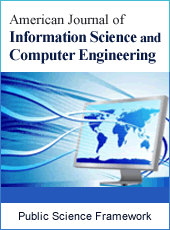American Journal of Information Science and Computer Engineering
Articles Information
American Journal of Information Science and Computer Engineering, Vol.3, No.6, Nov. 2017, Pub. Date: Dec. 9, 2017
Optimisation of Self Organising Maps Using the Bat Algorithm
Pages: 77-83 Views: 2280 Downloads: 951
[01]
Kernan Mzelikahle, Computer Science Department, National University of Science and Technology, Bulawayo, Zimbabwe.
[02]
Dunstan Junior Mapuma, Computer Science Department, National University of Science and Technology, Bulawayo, Zimbabwe.
[03]
Dumisani John Hlatywayo, Applied Physics Department, National University of Science and Technology, Bulawayo, Zimbabwe.
[04]
John Trimble, Industrial Engineering Department, Tshwane University of Technology, Tshwane, South Africa.
Self Organising Maps are among the most widely used unsupervised neural network approaches to clustering. They have been shown to be efficient in handling large and high dimensional data. The Bat Algorithm is a swarm intelligence based, meta-heuristic optimisation algorithm. It is based on the echolocation behaviour of micro-bats with varying emission pulse rates and loudness. This paper gives a novel hybrid optimisation method which is here called the Bat Optimised Self-Organising Map. It combines the basic Self Organising Map learning algorithm with the Bat Algorithm. In this optimisation technique, the Bat Algorithm is used to initialise the weight vectors for a Self Organising Map to a near global optimum prior to the competition.
Self Organising Maps, Bat Algorithm, Artificial Neural Networks, Unsupervised Learning
[01]
Ajith, A., Aboul-Ella, H., and Carvalho, A. (2009). Foundations of Computational Intelligence Volume 4: Bio-Inspired Data Mining: Studies in Computational Intelligence, Germany, Springer Verlag.
[02]
Aoki, T., Ota, K., Kurata, K. and Aoyagi, T. (2009). Ordering Process of Self-Organizing Maps Improved by Asymmetric Neighborhood Function. Cognitive neurodynamics, 3(1), pp. 9-15.
[03]
Brownlee, J. (2011). Clever algorithms: nature-inspired programming recipes. Jason Brownlee.
[04]
Chaudhary, V., Ahlawat, A. K. and Bhatia, R. S. (2011). Growing Neural Networks using Soft Competitive Learning. International Journal of Computer Applications, pp. 975-987.
[05]
Diehl, P. U. and Cook, M. (2015). Unsupervised Learning of Digit Recognition using Spike-Timing-Dependent Plasticity. Frontiers in Computational Neuroscience, 9.
[06]
Erwin, E., Obermayer, K., and Schulten, K. (1992). Self-Organising Maps: Ordering, Convergence Properties and Energy Functions. Biological Cybernetics, 67: 47-55. DOI: 10.1007/BF00201801.
[07]
Fisher, R. A. (1936). The use of multiple measurements in taxonomic problems. Annals of human genetics, 7(2), pp.179-188.
[08]
Gurney, K. (2004). An Introduction to Neural Networks. London: Taylo and Francis e-Library, University College London (UCL).
[09]
Kaiichiro, O., Takaaki, A., Koji, K and Toshio, A. (2011). Asymmetric Neighborhood Functions Accelerate Ordering Process of Self-Organizing Maps. Physical Review. E, Statistical, Nonlinear, and Soft Matter Physics Journal Vol 83, DOI: 10.1103/PhysRevE.83.021903.
[10]
Kohonen, T. (1982). Self-Organized Formation of Topologically Correct Feature Maps. Biological Cybernetics, 43, pp. 59-69.
[11]
Madani, K. (2006). Industrial and Real World Applications of Artificial Neural Networks: Illusion or reality? Informatics in Control, Automation and Robotics, Vol. I, Springer, ISBN 1-4020-4136-5, pp. 11-26.
[12]
Malsburg, C. (1973). Self-Organization of Orientation Sensitive Cells in the Striate Cortex. Kybernetic, 14, pp. 85-100.
[13]
Salomon, L. A., Fort, J. C. and Chang, L. V. (2012). Average Competitive Learning Vector Quantization. MAP5 2012-10 .
[14]
Schmidhuber, J. (2015). Deep Learning in Neural Networks: An Overview. Neural Networks, Vol 61, pp 85-117. DOI: 10.1016/j.neunet.2014.09.003.
[15]
Yang, X. S. (2010). A New Metaheuristic Bat-Inspired Algorithm. In: Nature Inspired Cooperative Strategies for Optimisation, pp. 65-74. Springer.
[16]
Yang, X. S. and Gandomi, A. H. (2010). Bat Algorithm: A Novel Approach for Global Engineering Optimization. Vol. 29 Iss: 5 pp. 464 –483.

ISSN Print: 2381-7488
ISSN Online: 2381-7496
Current Issue:
Vol. 7, Issue 3, September Submit a Manuscript Join Editorial Board Join Reviewer Team
ISSN Online: 2381-7496
Current Issue:
Vol. 7, Issue 3, September Submit a Manuscript Join Editorial Board Join Reviewer Team
| About This Journal |
| All Issues |
| Open Access |
| Indexing |
| Payment Information |
| Author Guidelines |
| Review Process |
| Publication Ethics |
| Editorial Board |
| Peer Reviewers |


